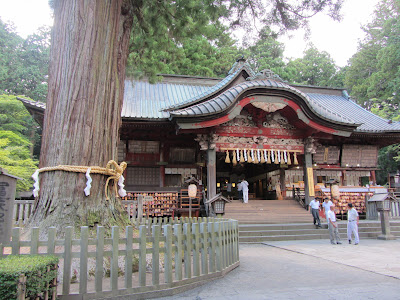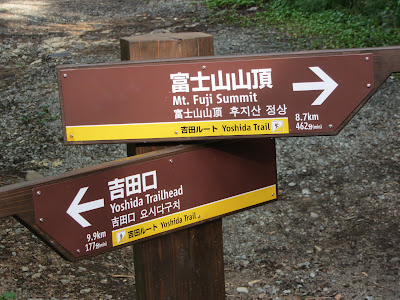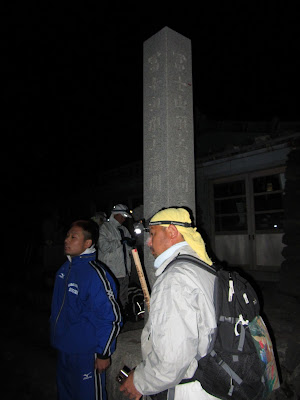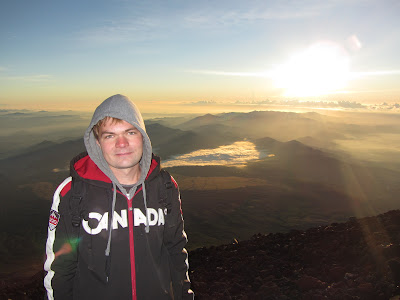So I climbed Mount Fuji. That doesn't necessarily sound like that much of an accomplishment since it is the most climbed mountain in the world, with 300,000 climbing up each year, mostly during the summer. When more than 99% of those people say they climbed Mt. Fuji though, they mean they took a bus up to one of the 5th stations then climbed from there to the summit. When I say I climbed Mt. Fuji, I mean I climbed Mt. Fuji.
While I was considering options for ascent from Kawakuchiko, I came to the conclusion that I really wanted to do the old, traditional route all the way from the Fujiyoshida Sengen Shrine in town at the base of the mountain and following the Yoshida trail all the way to the 5th station where all the other climbers would join on for the rest of the climb. This adds about 15km and 5 hours onto the hike, but I did it for a few reasons. Partly I just wanted to do something a bit different and really challenge myself and partly I just thought it would be a more interesting climb; Up until the 5th/6th station the trails go through woods and beyond it's just climbing up volcanic rock. I did, however, decide to do the top section of the climb at night, which is one of the most common ways of doing it, but I'll get to details on that later.
Because the supplies sold at stations on the way up are so expensive I carried everything I needed up with me. For food and water I had 2L of water, a bag of octopus jerky, some unsalted peanuts, 3 squeeze packs of special energy gel, and half a bag of taco-flavoured potato chips I had left over. I also had both my hoodie and jacket, a rain poncho, a small $2 flashlight which was all I could find, some sunblock and a hat. I originally packed my warm snowboarding pants as well, but removed them before I left to try to cut down on weight.
I started from the Mt. Fuji train stop, and it was a few kilometers from there to the Fujiyoshida Sengen Shrine.
For the first big chunk of the walk, long before even the 1st station, it was just walking through woods along a gravel path near the road. This forest (although I'm not if I was exactly the right spot of it) is called Aokigahara, and is full of legends about Japanese mythological creatures, as well as being famous for people committing suicide. Along the way the trail passes Nakanochaya, which is a tea house and an area supposedly with a lot of wildlife (I only saw birds, but the area is a national park and contains a lot of deer, bears and wild boar, among other things) and Umagaeshi, which is the entrance to the sacred part of the mountain. Originally you couldn't take horses past this point, so it's a bit sad that now they have road access to points much higher up the mountain. There are a lot of little shrines and carved stones in this part.
I took a short break at Umagaeshi to have tea with 3 older ladies just sitting there asking travellers to have tea with them. I think it's the first conversation I've ever had in Japan where my knowledge of Japanese was more helpful than their knowledge of English, but they were very sweet. A short hike later and I reached the 1st station. From here it became a bit more steep, but it was still going through forest. The "stations" from 1-4 were buildings that were abandoned and falling apart. It was all very quiet. For the first 6 hours, from the shrine to the 6th station I only saw 6 other hikers, all Japanese. From the 3rd station to somewhere past the 4th I was hiking through clouds, so the humidity was pretty brutal.
The trail I was on skipped the 5th station (it's off to the side a bit) so I met up with all the hikers at the 6th station just around sunset. This was also my first time above the treeline and the first chance I had to look down at the way I'd come.
I took less pictures for the rest of the climb, as it was dark out and there wasn't a lot to see. It was a clear night, and you could see the lights from all the surrounding towns spidering out (although hard to take a picture of) and the trail of lights above and below from other climbers. The trail is very steep, sometimes just zig-zagging back and forth but fairly smooth, and sometimes being piles of volcanic rock you just have to scramble up over.
About halfway between the 7th and 8th stations my cheap flashlight broke. At first I just thought it was the battery, but a fresh battery didn't fix it. I guess that's why $2 flashlights are $2. I did a few sections in the dark with a little ambient lighting from the stars, stations along the way and lights below, but eventually I latched onto a large group going up with a guide that provided enough light for me to see fairly well. It was getting quite cold by this point, and I had both jackets on. I found the temperature fine if I was moving, but it got cold pretty quickly when I sat still to rest. I was 2 or 3 hours ahead of schedule, mostly because I had started a bit early, not being sure how long it would take with the extra bit at the start. I tried to stretch out my breaks at each station and rest cabin, both to kill time and to adjust to the elevation. I never had any trouble with altitude sickness, but I saw others throwing up or using oxygen packs, so I didn't want to take any unnecessary risks. I got to the summit around 2:45am, with sunrise not until around 4:30am. The time between was absolutely miserable. I basically just found a niche out of the worst of the wind and curled up in a ball shivering, wishing I'd brought those winter pants along.
Finally the sky started to brighten on the horizon, and orange started to creep up into the deep blue of night. Progress was agonizingly slow, but eventually the sun finally peeked into view.
That wasn't the end though! The rising sun made things much warmer, and I decided to spend another hour hiking the path around the crater. I didn't want to come all this way and miss the highest point of the mountain (and thus of Japan), but getting up that last steep slope was a bit of a struggle for my weary legs. Moving to the other side of the summit also meant that I got to see Fuji's twin Kage Fuji (Fuji's shadow), which is apparently somewhat uncommon of an event.
It was finally time to start heading down, and the descent was pretty harsh. It was long slopes of volcanic gravel, and coming down was a half walk, half slide for 4 hours. The rock through up clouds of red and brown dust that covered everything, and people kept slipping and falling. The fact that many of the people hadn't slept probably didn't help.
Finally I got down to the 5th station and a few buses later was back in Tokyo where I'll spend a few more days before heading to another place in Japan that I couldn't fit in last time I was here.






























1 comment:
Congratulations! I knew climbing Mt. Fuji was a goal of yours. I had no idea though what all that involved. You'll probably be sore for a few days, so take it easy.
Post a Comment